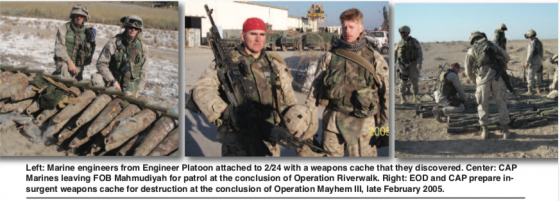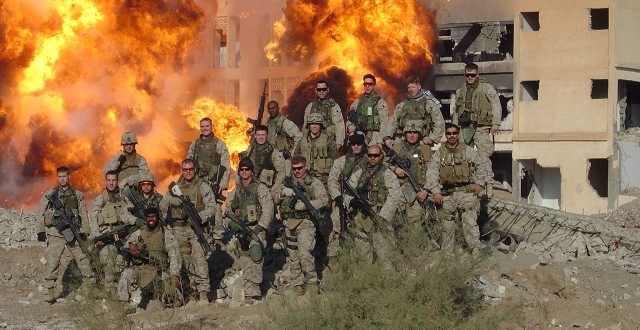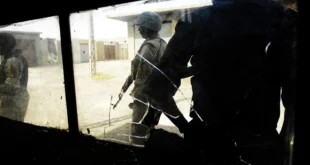
By Chuck Connon
From the June 2015 issue of SOF
June 16, 2006. Three US Army soldiers were assigned to protect an armored vehicle-launched bridge (AVLB) spanning a canal at the south end of Route Malibu. Their position was south of Baghdad, in a part of Iraq nicknamed the “Triangle of Death.” It was nearing 2000, and the soldiers had been on duty in their Humvee for almost 24 hours. They had just placed an order for steaks, via radio, with a nearby base hosting a birthday party. Little did they know that Iraqi insurgents, the forerunners of what we now call ISIS, were approaching their position. The insurgents had carefully rehearsed their attack, and the soldiers, taken totally by surprise, did not even get off a shot. One soldier made it to the bank of the canal before he was shot and killed. The other two soldiers were taken captive. ISIS had been severely mauled, but now they were back.
In September 2004, Lt. Col. Mark Smith’s 2/24 Marine Reservists entered Iraq’s Triangle of Death. His expectations were simple: “We went in there with the full expectation that we were going to do shit differently, and our goal was to set a standard on how you fight this enemy, this new asymmetric warfare. And you fight it by finding out who they are and killing them. That’s it.” In October, Lt. Col. Smith pushed the combat power of two of his three rifle companies out of their forward operating base (FOB) at Mahmudiyah. The two rifle companies established their own FOBs at Lutifiyah and Yusifiyah.
The insurgents, reinforced by hard chargers flooding in from Fallujah, tried to fight back. Then, on November 8, just north of Lutifiyah, a powerful improvised explosive device (IED) exploded, killing four Marines. Three days later, in the same area, insurgents set off an IED in front of a Marine patrol. A well-planned, two-stage ambush ensued. The insurgents fired on the Marines from an elevated position where they had dug in, shielded from the Marines by a canal. The Marines, however, fought back and drove the insurgents off after a fierce battle in which one brave Marine was killed when he exposed himself to enemy fire to protect his fellow Marines. The next day, in an attack unprecedented in the Iraqi conflict, the insurgents tried to overrun the FOB at Yusifiya. Seventy black-clad insurgents and one Marine died during this attack.
After the attack Lt. Col. Smith stated “This is now the most dangerous place in Iraq.” His Marines hunted insurgents with a vengeance. They established continuous, unpredictable patrols, used static and mobile traffic control points, and mounted night time raids. These tactics significantly unnerved the insurgents, who began to call the Marines “The Mad Ghosts.” By the time the Marines disembarked in March 2005, hostile acts had declined from an average of 12–18 per day to an average of one per week. The Mad Ghosts had killed around 400 insurgents and sent more than 950 to Abu Ghraib for long-term detention. Fourteen Mad Ghosts died as a result of their deployment in Iraq.
A battalion of the 2-70th Armor arrived in the Triangle of Death in March 2005 for relief in place/transfer of authority (RIP/TOA). Lt. Col. Smith said, “We tried as hard as we could to make them understand how intense the insurgents in our zone were. The problem was they (the follow-on units) were victims of our success. By the time they all started to come in, we had reduced enemy activity to virtually nothing… You can ask staff officers of mine who were in the briefs. My exact brief one day was, if you do not listen to what the fuck we are telling you, within a year, you will end up on CNN… An Army battalion is significantly smaller than a Marine battalion in numbers. And so, they were spread; they were thin and they were small. And the insurgency said we can get these guys. And they specifically targeted them.”
The Army’s 2-70th Armor was assigned to do the handoff with the Marines, and then immediately to begin a RIP/TOA with the 2nd Squadron of the 3rd Armored Calvary Regiment. Just after the Marines left, the 2nd Squadron arrived and unloaded their tanks at FOB Mahmudiyah. The next day, to the surprise of 2-70th Armor, the 2nd Squadron reloaded their tanks back onto their trailers and moved on. They had been reassigned to Tal Afar. Army Major Bryan Cecar said 2-70’s new timetable was, “We’re going to be here until whenever.” Their stay in the Triangle ended up being event driven instead of time driven. 2-70 ended up staying four months.
“Until whenever” ended when the 48th Infantry Brigade of the Georgia Army National Guard began to arrive in May 2005 for RIP/TOA. Most will agree they had a rough tour in the Triangle of Death. During one seven-day time period, eight soldiers were killed by massive IEDs. After that, the 48th, according to a Stars and Stripes article, became “focused on controlling a much smaller portion of the territory…” In October 2005, the 48th Brigade was assigned a change of mission. It handed off the Triangle of Death to the 2nd Brigade of the 101st Airborne Division. Over 24 soldiers of the 48th had been killed in action in the Triangle. The 48th moved farther south in Iraq to a much quieter area.
The 101st had a controversial tour in the Triangle of Death. Their tour, and the controversies that ensued, are described in the book Black Hearts. There were obvious leadership issues in the unit. Soldiers began referring to insurgents as the ghosts. Some poorly supervised soldiers raped an Iraqi girl, and murdered her and her family after drinking on duty. Shortly after that, the insurgents attacked the AVLB.
The insurgents had captured two US soldiers and inflicted on them the same type of barbaric acts ISIS commits today. After dying horrible deaths, their bodies were dragged behind a pickup truck through adjacent Yusifiyah, then dumped near an abandoned power plant at the north end of Route Malibu. The soldiers’ captors made a grisly video at the end of the event.
The single US Army platoon that was involved in the ambush and rape was reassigned to guard duty at FOB Mahmudiyah. In the fall of 2006, advance parties of the 10th Mountain Division began to arrive for the handoff. The book None Left Behind describes their tour.
During their tour, the 10th Mountain had a static position overrun in a rehearsed night-time assault. Six US soldiers and one Iraqi in two Humvees manned the position on Route Malibu. Three US soldiers were captured, and the rest were killed during the assault. A massive influx of troops flooded the area in a search for the captured US soldiers. Eventually, the bodies of the slain soldiers were found. By this time, the insurgents on Route Malibu were referring to themselves as Islamic State.
Finally, US forces began to re-establish control over Route Malibu and the Triangle of Death. The 10th Mountain left Iraq, as scheduled, after losing 26 soldiers in action. Two of their captured soldiers were still listed as missing in action. ISIS, for the most part, moved on to an area with less US presence.
When the 10th Mountain returned to the United States, a platoon sergeant stood in front of a glass case. It contained photographs of soldiers in his battalion who had sacrificed their lives while serving in Iraq and Afghanistan. As he stood there, his battalion commander approached him. The lieutenant colonel began speaking, “Sometimes it’s easy for us to convince ourselves that the United States is a decadent society, that our young people have gone soft and that we’ll never produce another generation like the one that stormed Normandy on D-day. Anyone who thinks that, wasn’t in The Triangle of Death.”
 Soldier of Fortune Magazine The Journal of Professional Adventurers
Soldier of Fortune Magazine The Journal of Professional Adventurers






